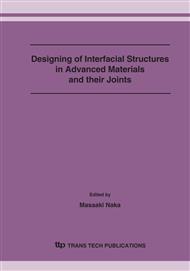p.185
p.189
p.195
p.203
p.209
p.215
p.221
p.227
p.233
Characterization and Dissolution Behavior in a Physiological Solution of Heat-Treated CaTiO3 Thin Films with Different Thicknesses
Abstract:
Characterization of heat-treated CaTiO3 thin films of 10, 20, 30 and 50 nm in thickness and their change after immersion in a simulated body fluid were investigated by grazing incident angle X-ray diffractometry and Auger electron spectroscopy (AES). The CaTiO3 films were prepared on titanium substrate by sputter-deposition of CaTiO3 target followed by heating in an electric furnace at 873 K in air for 7.2 ks. The CaTiO3 films were immersed in 0.8% NaCl solution for 14 d. All the films before heat treatment were non-crystallized films and after heat treatment, only the 50-nm film was crystallized to perovskite-type CaTiO3. In AES in-depth profiles after heating, Ca diffusion was not observed in the 50-nm film, whereas Ca diffusion toward the Ti substrate was observed in the 10-, 20- and 30-nm films. After immersion for 14 d, the vicinity of surface of the 10, 20 and 30 nm thick CaTiO3 films were dissolved into the NaCl solution, while the 50-nm thick CaTiO3 film was scarcely dissolved. Since dissolution from biomaterials in a human body has possibility to harm, the CaTiO3 film should be deposited more than 50 nm in thickness and heat-treated at 873 K.
Info:
Periodical:
Pages:
209-214
Citation:
Online since:
September 2007
Authors:
Price:
Сopyright:
© 2007 Trans Tech Publications Ltd. All Rights Reserved
Share:
Citation:


